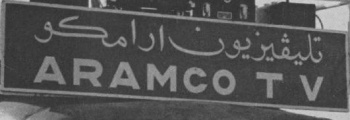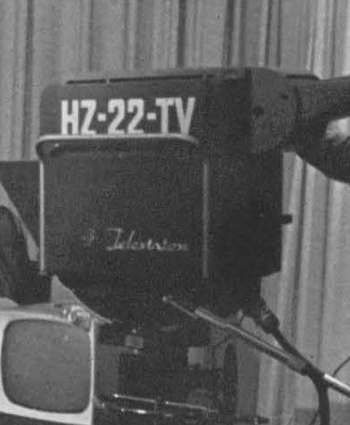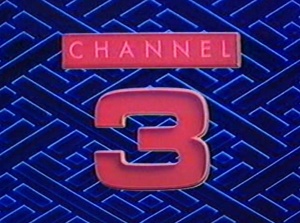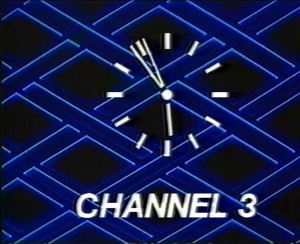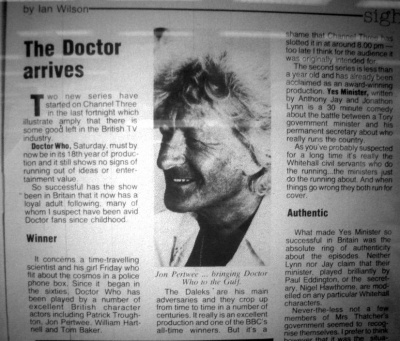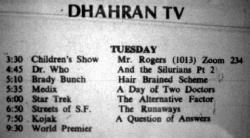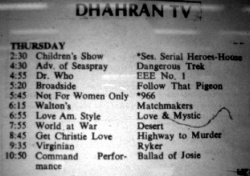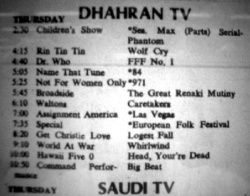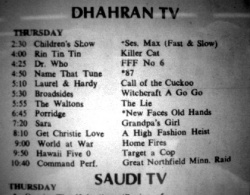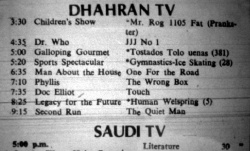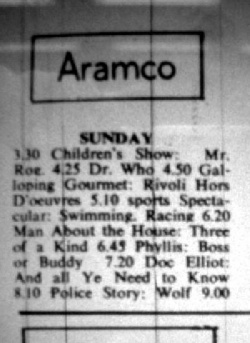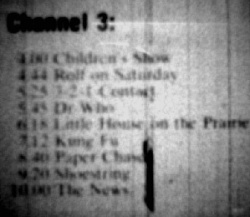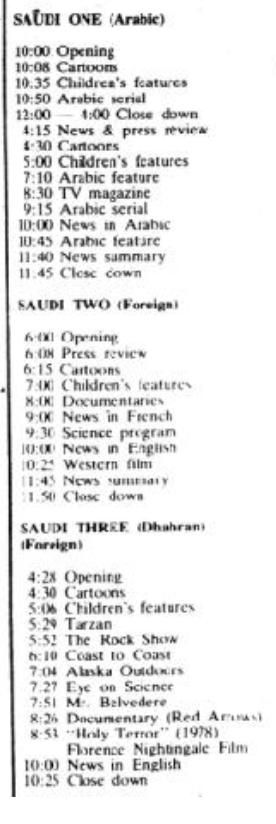Difference between revisions of "Saudi Arabia"
Jon Preddle (talk | contribs) |
Jon Preddle (talk | contribs) |
||
| Line 53: | Line 53: | ||
Despite the switch to PAL, the old NTSC colour channel 2 continued broadcasting through the 1980s, airing English language programming, much of which came from the United States. | Despite the switch to PAL, the old NTSC colour channel 2 continued broadcasting through the 1980s, airing English language programming, much of which came from the United States. | ||
| − | '''Doctor Who''' aired on ARAMCO TV's PAL Channel 3 between 1977 and 1982, and its NTSC channel 2 circa | + | '''Doctor Who''' aired on ARAMCO TV's PAL Channel 3 between 1977 and 1982, and its NTSC channel 2 circa 1985-87. |
The ARAMCO station eventually closed in 1998. | The ARAMCO station eventually closed in 1998. | ||
| Line 79: | Line 79: | ||
Broadcasts from [[Kuwait]] could also be received in eastern Saudi Arabia, and from 1973, colour transmissions from [[Bahrain]] could also be received. | Broadcasts from [[Kuwait]] could also be received in eastern Saudi Arabia, and from 1973, colour transmissions from [[Bahrain]] could also be received. | ||
| + | |||
| + | Transmissions from the [[United Arab Emirates]] could also at times also be received. | ||
| Line 273: | Line 275: | ||
<br / clear="all"> | <br / clear="all"> | ||
<br /> | <br /> | ||
| + | |||
ARAMCO (Channel 2) appears to have bought the standard package of [[Tom Baker stories]] that had been edited into omnibus "movies" that was distributed by Lionheart. | ARAMCO (Channel 2) appears to have bought the standard package of [[Tom Baker stories]] that had been edited into omnibus "movies" that was distributed by Lionheart. | ||
| Line 331: | Line 334: | ||
</div> | </div> | ||
| − | ARAMCO (Channel 3) appears to have bought the remaining [[Tom Baker stories]] (or maybe only some of them), and aired them as "omnibus" editions. Although the sale itself was probably still handled by Lionheart, the tapes supplied in the PAL format in English were likely sourced from the [[United Arab Emirates]], where those stories were screening episodically at the time. (It would seem that ARAMCO edited the stories into "movies" themselves as that was how the others had been screened.) | + | ARAMCO (Channel 3) appears to have bought the remaining [[Tom Baker stories]] (or maybe only some of them), and aired them as "omnibus" editions. |
| + | |||
| + | It is possible that the "(4)" stories sold by February 1987 as noted in '''The Eighties''' might relate solely to the PAL episodes - in which case, and on the basis that one of them was [[Full Circle]] (as covered below) - the stories that aired in Saudi Arabia in the mid/late 1980s might be from season 18 only… | ||
| + | |||
| + | Although the sale itself was probably still handled by Lionheart, the tapes supplied in the PAL format in English were likely sourced from the [[United Arab Emirates]], where those stories were screening episodically at the time. (It would seem that ARAMCO edited the stories into "movies" themselves as that was how the others had been screened.) | ||
| Line 407: | Line 414: | ||
(See also [http://chicago.epguides.com/DoctorWho/variations.aspx UNDERWORLD VARIATIONS] for more about these variations (scroll down to 1991).) | (See also [http://chicago.epguides.com/DoctorWho/variations.aspx UNDERWORLD VARIATIONS] for more about these variations (scroll down to 1991).) | ||
| − | When Channel 2 ended its run of NTSC omnibuses of fourth Doctor stories, ARAMCO'S PAL Channel 3 started screening PAL omnibuses of fourth Doctor stories! (Or there may even have been a | + | When Channel 2 ended its run of NTSC omnibuses of fourth Doctor stories, ARAMCO'S PAL Channel 3 started screening PAL omnibuses of fourth Doctor stories! (Or there may even have been a period of overlap when both channels were screening '''Doctor Who''' at the same time.) |
| − | [[Full Circle]] | + | The only story known to have definitely aired was [[Full Circle]], circa '''May or June 1986'''. |
Our man on the scene says: ''"It is possible that both channels were airing '''Doctor Who''' simultaneously: the NTSC ones on Channel 2 had finished broadcasting by the time I got out to Saudi - my father recorded them so these were probably on during early 1986 but [[Full Circle]] on Channel 3 - as it is on one of my tapes - must have been while I was out there in the summer (May-June)." '' | Our man on the scene says: ''"It is possible that both channels were airing '''Doctor Who''' simultaneously: the NTSC ones on Channel 2 had finished broadcasting by the time I got out to Saudi - my father recorded them so these were probably on during early 1986 but [[Full Circle]] on Channel 3 - as it is on one of my tapes - must have been while I was out there in the summer (May-June)." '' | ||
| Line 457: | Line 464: | ||
'''1985-1986 (1987?)''' | '''1985-1986 (1987?)''' | ||
| − | We have yet to find clear listings for the [[Tom Baker stories]] broadcast on ARAMCO's Saudi 2 channel and Channel 3 from 1985 to 1986 (and 1987?). For this range of dates, the ''Arab News'' only had television listings on an infrequent basis, and when they did have schedules, they | + | We have yet to find clear listings for the [[Tom Baker stories]] broadcast on ARAMCO's Saudi 2 channel and Channel 3 from 1985 to 1986 (and 1987?). For this range of dates, the ''Arab News'' only had television listings on an infrequent basis, and when they did have schedules, they identified programmes only by type (e.g. "Children's feature") rather than by title. |
During '''mid-August''' through until the end of '''September 1986''' some days have a 90, 110 or 120 minute "Feature" in the early-evening, all of which could potentially be omnibuses of '''Doctor Who'''. | During '''mid-August''' through until the end of '''September 1986''' some days have a 90, 110 or 120 minute "Feature" in the early-evening, all of which could potentially be omnibuses of '''Doctor Who'''. | ||
Revision as of 04:52, 27 May 2012
SAUDI ARABIA is a Middle Eastern country, between the Red Sea and the Persian / Arabian Gulf.
Profile
| Country Number (27) | 1968? | FIRST, SECOND and THIRD WAVE |
| Region | Middle East | |
| Television commenced | 17 June 1955 | |
| Colour System 1 | 1973 | SECAM |
| Colour System 2 | 1976 | NTSC |
| Colour System 3 | 1979 | PAL |
| Population | 1969 | 7 million |
| TV Sets | 1969 | 29,000 |
| Population | 1977 | 8.1 million |
| TV Sets | 1977 | 130,000 |
| Language/s | Arabic and English | Dubbed or Subtitled |
Television Stations / Channels
Despite its vast size, television coverage in Saudi Arabia is isolated to only two specific regions: Riyadh and Jidda in the west, and the south eastern provinces near Dhahran on the Persian Gulf. By 1970, it had six separate broadcasters serving the country.
AJL-TV
The second-ever television service to the Arab world was established in Saudi Arabia; commencing from 17 June 1955, station AJL-TV went on air in Dhahran on the Arabian / Persian Gulf. This NTSC service was operated by the United States Air Force, and was intended to provide entertainment to personnel at the Dhahran Air Force Base.
ARAMCO TV / HZ-22 (Channel 2) / CHANNEL 3
On 16 September 1957, another NTSC broadcaster was established in the nearby compound of the Arabian American Oil Company (ARAMCO); Station HZ-22 channel 2 (aka Dhahran TV) broadcast both Arabic and English programming. The English material was a mixture of dubbed, subtitled or narrated (in which the origin soundtrack played but with an Arabic voice-over providing narration). In the case of dubbed material, the original English soundtrack was often also broadcast by FM radio, allowing for simulcast in both languages.
When the new Damman station (see below) went on the air in 1970, ARAMCO ceased its Arabic service, and all subsequent broadcasts from HZ-22 / channel 2 were in English.
In November 1976, ARAMCO modified its monochrome 525-line transmitters to broadcast in NTSC colour. Three years later, in March 1979, it installed a PAL colour transmitter which brought compatibility to the station and the neighbouring gulf nations (Bahrain, United Arab Emirates, Kuwait) that were already broadcasting in PAL. This PAL colour station was simply called Channel 3.
Despite the switch to PAL, the old NTSC colour channel 2 continued broadcasting through the 1980s, airing English language programming, much of which came from the United States.
Doctor Who aired on ARAMCO TV's PAL Channel 3 between 1977 and 1982, and its NTSC channel 2 circa 1985-87.
The ARAMCO station eventually closed in 1998.
These sites contain further information about ARAMCO:
SAUDI TV
The Saudi government's Ministry of Information began its own television broadcasts from Riyadh and Jidda from 17 July 1965.
Colour transmissions on Saudi TV began in 1973 using the SECAM colour broadcast system.
OTHER STATIONS
Fourth, fifth and sixth separate broadcast services were established over the ensuing years, with the sixth of these launched in Damman in 1970.
Saudi viewers purchased dual-standard television sets to enable them to enjoy broadcasts coming from all the different stations, as all were broadcasting in different formats.
Broadcasts from Kuwait could also be received in eastern Saudi Arabia, and from 1973, colour transmissions from Bahrain could also be received.
Transmissions from the United Arab Emirates could also at times also be received.
Language/s
The principal language of Saudi Arabia is Arabic, although ARAMCO television broadcasts were also simulcast in English, for the benefit of the English-speaking workers at the oil-fields.
The dubbing and subtitling for programmes screened in Saudi Arabia was done in Lebanon.
DOCTOR WHO IN SAUDI ARABIA
الدكتور هو
Saudi Arabia was the 27th country to screen Doctor Who; it was the third to screen the series in Arabic (see Selling Doctor Who).
BBC Records
The Seventies records a sale of "(4)" stories by 28 February 1977. The Handbook identifies these as being: C, E, J and L.
The Eighties - THE LOST CHAPTERS records a sale of "(25)" stories (by 10 February 1987).
Only 21 Jon Pertwee stories aired, so the balance of four would be Tom Baker stories, to make up the 25 (at least) sold by February 1987.
In DWM, Saudi Arabia is identified in only 16 story Archives: the same four Hartnells as above, plus K, with year of sale given as 1967 or 1968; and for Pertwee, it is recorded under AAA, BBB, DDD, EEE, KKK, MMM, LLL, RRR, PPP, QQQ, UUU, with the year of sale being 1977.
Stories bought and broadcast
WILLIAM HARTNELL
Nine stories, 37 episodes:
| A | An Unearthly Child | 1 |
| B | The Daleks | 7 |
| C | Inside the Spaceship | 2 |
| E | The Keys of Marinus | 6 |
| F | The Aztecs | 4 |
| G | The Sensorites | 6 |
| J | Planet of Giants | 3 |
| K | The Dalek Invasion of Earth | 6 |
| L | The Rescue | 2 |
Saudi Arabia therefore bought the standard package of GROUP A, B and C of the William Hartnell stories dubbed into Arabic.
Origin of the Prints?
Tunisia and Morocco had screened the Hartnell stories by the time Saudi Arabia began so it's possible the prints sent to Saudi Arabia came from one of these two countries. Saudi Arabia was also a distribution client of Television International Enterprises Ltd / TIE (Programmes) Ltd (see WRTH), who had previously supplied prints to Aden. However, given that the prints sent to Saudi Arabia would most likely have been dubbed into Arabic, TIE Ltd might not have supplied the prints.
The programme was supplied as 16mm black and white film prints with Arabic soundtracks. It is possible that the broadcaster was also supplied with English prints, enabling a simulcast in both languages, with the English soundtrack available on the radio.
JON PERTWEE
21 stories, 112 episodes (presumably):
NTSC Colour Channel HZ-22
| AAA | Spearhead from Space | 4 |
| BBB | Doctor Who and the Silurians | 7 |
| CCC | The Ambassadors of Death | 7 |
| DDD | Inferno | 7 |
| EEE | Terror of the Autons | 4 |
| FFF | The Mind of Evil | 6 |
| GGG | The Claws of Axos | 4 |
| HHH | Colony in Space | 6 |
| JJJ | The Daemons | 5 |
| KKK | Day of the Daleks | 4 |
| LLL | The Sea Devils | 6 |
| MMM | The Curse of Peladon | 4 |
| NNN | The Mutants | 6 |
| OOO | The Time Monster | 6 |
| PPP | Carnival of Monsters | 4 |
| QQQ | Frontier in Space | 6 |
| SSS | Planet of the Daleks | 6 |
PAL Colour Channel 3
| UUU | The Time Warrior | 4 |
| XXX | Death to the Daleks | 4 |
| YYY | The Monster of Peladon | 6 |
| ZZZ | Planet of the Spiders | 6 |
Saudi Arabia therefore bought all of GROUP A, B, C, and E, only some of D.
(Other BBC records indicate that the sale of The Three Doctors was "CANCELLED"; Strict Saudi censorship did not permit programmes that featured "god-like" beings, of which Omega may have been considered; The Green Death was never offered, possibly on account of its strong views against oil pollution...; and Invasion of the Dinosaurs was not available at all.)
ARAMCO was broadcasting in NTSC colour from 1976; since not all of the Pertwee stories were converted into NTSC by 1977, it is unclear in which format these episodes aired. U-Matic colour video tapes were in common usage by ARAMCO in the 1970s, so it is feasible that the BBC supplied ARAMCO with the first four Pertwee seasons in that format, rather than as b/w film. However, the TV listings seem to denote colour programmes with an asterisk (*) and none of the Doctor Who listings are marked as such, which does suggest that, like much of the TV schedules at that time, these were in black and white.
ARAMCO commenced PAL colour broadcasts after 1979. The final four season 11 stories would have been supplied on PAL colour video tape in English.
TOM BAKER
ARAMCO – Channel 2 (NTSC)
23 stories, equivalent of 98 episodes edited into "omnibus" movies:
| 4A | Robot | 4 |
| 4B | The Sontaran Experiment | 2 |
| 4C | The Ark in Space | 4 |
| 4D | Revenge of the Cybermen | 4 |
| 4E | Genesis of the Daleks | 6 |
| 4F | Terror of the Zygons | 4 |
| 4G | Pyramids of Mars | 4 |
| 4H | Planet of Evil | 4 |
| 4J | The Android Invasion | 4 |
| 4K | The Brain of Morbius | 4 |
| 4L | The Seeds of Doom | 6 |
| 4M | The Masque of Mandragora | 4 |
| 4N | The Hand of Fear | 4 |
| 4P | The Deadly Assassin | 4 |
| 4Q | The Face of Evil | 4 |
| 4R | The Robots of Death | 4 |
| 4S | The Talons of Weng-Chiang | 6 |
| 4V | Horror of Fang Rock | 4 |
| 4T | The Invisible Enemy | 4 |
| 4X | Image of the Fendahl | 4 |
| 4W | The Sun Makers | 4 |
| 4Y | Underworld | 4 |
| 4Z | The Invasion of Time | 6 |
ARAMCO (Channel 2) appears to have bought the standard package of Tom Baker stories that had been edited into omnibus "movies" that was distributed by Lionheart.
The programmes would have been supplied to ARAMCO on NTSC colour video tape in English. ARAMCO's channel 2 was still NTSC capable, and therefore the episodes aired on that channel rather than the PAL Channel 3.
ARAMCO – Channel 3 (PAL)
Potentially 18 stories, equivalent of 74 episodes edited into "omnibus" movies:
| 5A | The Ribos Operation | 4 |
| 5B | The Pirate Planet | 4 |
| 5C | The Stones of Blood | 4 |
| 5D | The Androids of Tara | 4 |
| 5E | The Power of Kroll | 4 |
| 5F | The Armageddon Factor | 6 |
| 5J | Destiny of the Daleks | 4 |
| 5H | City of Death | 4 |
| 5G | The Creature from the Pit | 4 |
| 5K | Nightmare of Eden | 4 |
| 5L | The Horns of Nimon | 4 |
| 5N | The Leisure Hive | 4 |
| 5Q | Meglos | 4 |
| 5R | Full Circle | 4 |
| 5P | State of Decay | 4 |
| 5S | Warriors' Gate | 4 |
| 5T | The Keeper of Traken | 4 |
| 5V | Logopolis | 4 |
ARAMCO (Channel 3) appears to have bought the remaining Tom Baker stories (or maybe only some of them), and aired them as "omnibus" editions.
It is possible that the "(4)" stories sold by February 1987 as noted in The Eighties might relate solely to the PAL episodes - in which case, and on the basis that one of them was Full Circle (as covered below) - the stories that aired in Saudi Arabia in the mid/late 1980s might be from season 18 only…
Although the sale itself was probably still handled by Lionheart, the tapes supplied in the PAL format in English were likely sourced from the United Arab Emirates, where those stories were screening episodically at the time. (It would seem that ARAMCO edited the stories into "movies" themselves as that was how the others had been screened.)
Transmission
WILLIAM HARTNELL
We have not been able to access Saudi Arabian newspapers from the late 1960s, and therefore do not have any details on these transmissions.
The series would have screened either on the Saudi TV or the ARAMCO TV channel.
Fate of the Prints?
Jordan was the next Arabic country in the Middle East to air Doctor Who (from mid-1969). It is possible that Saudi Arabia sent its prints of the Hartnell stories to Jordan (which was not a client of TIE Ltd).
.
JON PERTWEE
Nine or so years after the William Hartnell Doctor featured on Saudi TV screens, the good Doctor returned in 1977 – now played by Jon Pertwee.
The newspaper listings are a bit erratic from mid 1976 until the start of 1977, so we are uncertain as to the exact start date for the Jon Pertwee run, but the first clear listing is for part two of Doctor Who and the Silurians on Tuesday, 26 April 1977 on DHAHRAN TV (i.e. ARAMCO). (This start is only a few days after the brief run of Pertwee episodes commenced in Lebanon). The timeslots fluctuated, with the earliest at 4.45pm and the latest 5.55pm.
ARAMCO had dropped its Arabic programming in 1970, so these episodes were all broadcast in English. They were (most likely) also in black and white.
From 11 August 1977, the series shifted to Thursdays, usually at 4.55pm. From Sunday, 25 September, a second episode was added to the schedules (at 4.20pm), so the series played twice a week – Sundays and Thursdays. The timeslot for both weekly episodes fluctuated during the run.
There were two dates on which episodes did not air – 2 August 1977 and 22 September 1977; however the accuracy of the listings is under question for reasons outlined below.
The series did not screen in correct story order; in fact it looks very much as though the schedulers played the serials according to "theme" – it seems ARAMCO may have run the first seven stories featuring Roger Delgado as the Master (from seasons 8 and 9) in a 'block' (there are certainly enough airdates for this to have been the case), followed by The Ambassadors of Death, then the first two Pertwee Daleks stories back to back, with a four-parter (Spearhead from Space, The Curse of Peladon, Carnival of Monsters?) to finish.
The only ten stories are identified by title or story code: Doctor Who and the Silurians, CCC, Inferno, EEE, FFF, GGG, HHH, JJJ, KKK, SSS, which accounts for 56 episodes.
According to the Gulf Mirror, the run lasted for at least 72 episodes, and concluded on Sunday, 19 March 1978. However, the Arab Times continued to list the series until 22 April 1978 – but for reasons outlined below, we have reason to doubt the accuracy of these Times listings.
A new run of only six episodes aired from Saturday, 8 July 1978, at 4.40pm. Again, no titles were given; presumably this 6-parter was either The Sea Devils, The Mutants, The Time Monster or Frontier in Space, as these are the only 6-parters not identified during the previous 1977-1978 run.
NOTE: There were no ARAMCO listings for Doctor Who in the Gulf Mirror between 20 April 1978 and 8 July 1978; however given that we are short several episodes, it is possible that these "missing" episodes have slipped under the radar. From 22 April, the usual Doctor Who slot was taken by the American comedy Dennis the Menace, but the accuracy of those listings is under question...
After a three year break, the series returned, now on the newly-established PAL colour Channel 3. The first episode was at 8.04pm on Saturday, 21 November 1981. This slot moved around a bit during the run, with 5.54 or 5.45pm being the two most common.
This 20-episode run was previewed by the article, "The Doctor arrives", in the Gulf Mirror which was illustrated with a photo of Jon Pertwee – see image above.
ARAMCO/Channel 3 transmitted in PAL colour from 1979, so these 20 episodes would most likely have all been from season 11 (sans Invasion of the Dinosaurs).
The last recorded Channel 3 episode was on 3 April 1982.
Assuming ARAMCO purchased all the available Pertwee stories, there are 10 to 14 episodes not accounted for. The first run was for (at least) 72 weeks/episodes; the second only six, and the third and last for 20. That is only 98 out of a potential 112. It is possible that Spearhead from Space didn't screen – there is no listing for it ahead of Doctor Who and the Silurians – which potentially leaves just one 4-parter and one 6-parter unaccounted for.
Fate of the Tapes?
Saudi Arabia appears to be the last-ever country to screen a full run of season 7 to 10 Jon Pertwee stories from black and white film. With the exception of Bangladesh, who aired a handful in black and white in 1980, all other countries screened what was then left of the third Doctor stories still in PAL colour.
.
TOM BAKER
"Omnibus" editions of Tom Baker stories, Robot through to The Invasion of Time, aired on ARAMCO's NTSC Channel 2 (aka SAUDI TWO).
We do not have confirmed airdates for these broadcasts, but someone who actually watched them at the time tells us that the stories aired around mid-1985 to early 1986 (which certainly ties in with at least four stories having been sold by February 1987, per The Eighties).
One surprising recollection made by our viewer is that one short scene in the movie omnibus of Underworld retained a brief section of the old Howard da Silva narration (added to the episodes by the United States distributor in 1978), but which was accidentally left in when the episodes were re-edited into their "movie" omnibus editions in 1981. The voice-over says: "The signal from the missing ship grows stronger as the crew plummets to the underworld". This confirms that the NTSC tapes were sourced from the United States. (See the Underworld page for a clip with this narration.)
(See also UNDERWORLD VARIATIONS for more about these variations (scroll down to 1991).)
When Channel 2 ended its run of NTSC omnibuses of fourth Doctor stories, ARAMCO'S PAL Channel 3 started screening PAL omnibuses of fourth Doctor stories! (Or there may even have been a period of overlap when both channels were screening Doctor Who at the same time.)
The only story known to have definitely aired was Full Circle, circa May or June 1986.
Our man on the scene says: "It is possible that both channels were airing Doctor Who simultaneously: the NTSC ones on Channel 2 had finished broadcasting by the time I got out to Saudi - my father recorded them so these were probably on during early 1986 but Full Circle on Channel 3 - as it is on one of my tapes - must have been while I was out there in the summer (May-June)."
"I don't know if this was a local case of bicycling - season 18 being shown in the UAE (e.g. Meglos) then the tapes being sent onto Saudi 3 very shortly after (e.g. Full Circle) - but the NTSC tapes probably may have come via America for Saudi 2 (remember that snippet of Howard da Silva narration I mentioned appearing on Underworld) and not via the usual UK sales."
"Saudi 1 was the more technically primitive, as I recall, and was probably broadcasting from the capital Riyadh, which I never got to visit … Saudi 3 was, I think, broadcasting from the Dhahran region, and the quality of transmission was usually superb."
From this (mainly anecdotal) information, it seems that Tom Baker aired in Saudi Arabia from:
- mid-1985 to early 1986 in NTSC (Robot to The Invasion of Time), and then:
- early 1986 (and on into 1987?) in PAL (The Ribos Operation? to Logopolis?) Unfortunately, as noted below, we have been unable to find clear TV listings to back this up…
TV listings
| ← AIRDATES ...... (CLICK ICON TO GO TO TABLE SHOWING EPISODE BREAKDOWN AND AIRDATES - N/S = story title is Not Stated) |
1960s
We have not been able to locate any newspapers with Saudi Arabian TV listings for this period.
1970s
TV listings have been obtained from the Saudi newspaper Arab News (an English publication from Jeddah), and the Bahraini paper, the Gulf Mirror, which has full TV listings for most of the neighbouring Gulf countries (but no issues available prior to October 1977).
The Gulf Mirror printed the series title as "Dr Who". No story titles were given.
In the Arab News, listings also gave the title as "Dr Who". Two of the serials were identified by name (with various different attempts at spelling "Silurians" and "Inverno" (sic)!)
Programmes marked with an asterisk (*) in the Arab News appear to denote that it is in colour. None of the 1970s listings for Doctor Who are marked that way, which suggests the episodes were all in black and white.
From the 11 August 1977 listing onwards, many episodes were identified only by the three-letter BBC production code and episode number, such as "EEE No 1", "CCC 1", "CCC EP 2", etc.
However it seems that the News experienced a glitch in its printing process, as the TV listings started being duplicated over and over for several weeks, with as many as nine listings being given for "FFF No 4" over an eleven week period, from October to December 1977. Glitches of this nature continued to plague the listings, with one extreme example of the problem occurring when the very same programme details (which included "Dr Who: KKK No1") were repeated every day from 15 March through until 22 April 1978! (when the listings for Doctor Who were replaced by the American comedy series Dennis the Menace).
To add further frustration, the two papers do not always agree with the timeslots, particularly the Thursday episodes, which are timed around 4.00pm in Arab News, but as early as 2.45pm in the Gulf Mirror (it's possible this is due to the time difference between the two countries, but if so that should be only an hour, not two or more). Also making it hard to reconcile the two sets of listings is that the Bahraini paper did not always date the days of the week in its pull-out TV guide, which sometimes started with Monday, sometimes Sunday, so it's possible we have "missed" some of the Sunday listings.
Given all these anomalies, we've done our best to combine the two sets of listings, but need to stress we do still have some uncertainty as to the accuracy of our valiant attempt!
1981
In the Gulf Mirror issue dated 21-27 November 1981, the new run of episodes starting that week was previewed by Ian Wilson in his Sight and Sound column. The article headed "The Doctor arrives" (see image above, next to the table of Jon Pertwee stories), is illustrated with a captioned photo of the lead actor, and says: "Jon Pertwee … bringing Doctor Who to the Gulf". The article mentions that the series had been running in the UK for 18 years, and names the other three actors to have played the title character, although oddly, Wilson does not mention that the series had aired in Saudi Arabia in the sixties, or indeed only four years earlier!
1985-1986 (1987?)
We have yet to find clear listings for the Tom Baker stories broadcast on ARAMCO's Saudi 2 channel and Channel 3 from 1985 to 1986 (and 1987?). For this range of dates, the Arab News only had television listings on an infrequent basis, and when they did have schedules, they identified programmes only by type (e.g. "Children's feature") rather than by title.
During mid-August through until the end of September 1986 some days have a 90, 110 or 120 minute "Feature" in the early-evening, all of which could potentially be omnibuses of Doctor Who.
Arabia in Doctor Who
- The Doctor and his friends found themselves running around a 1920s Hollywood film studio that was "full of Arabs" during The Daleks' Master Plan
- Garron once tried to sell Sydney Harbour to an "Arab" (The Ribos Operation)
- In his guise of Kalid, the Master said he learned his magic "in the deserts of Arabia", which in very broad terms could mean Saudi Arabia. (Time-Flight)
